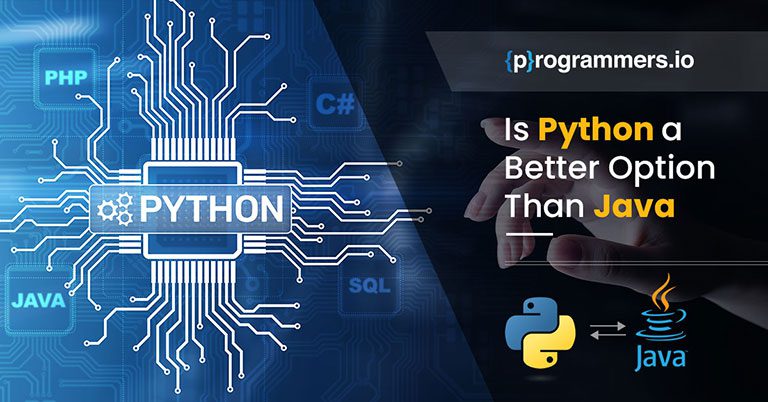Is Python a Better Option Than Java?
A programming language is best understood as a collection of commands, codes, and instructions that shape software development. The choice of language a developer makes plays a crucial role in determining the efficiency, quality, and overall success of the final product.
Given the importance of selecting the right programming language, developers often find themselves facing a challenging decision. Among the many languages available today, Java and Python stand out as two of the most powerful and widely trusted choices in the industry. Both have their unique strengths, making them suitable for different types of projects and development environments.
This article aims to explore the distinctive features of Java and Python, comparing them across several key parameters to help you understand where each language excels.
Understanding Basic Differences
Before diving into the specific features of both languages, it’s important to start with some fundamental differences that define their core characteristics.
Java
Java is a time-tested programming language known for its high-level coding capabilities, similar in structure to C++. It is a strictly object-oriented language. Designed to provide platform-independent coding features like the Java Virtual Machine (JVM), it allows developers to write code once and run it anywhere. Java is particularly valued for its robustness, minimal glitches, and lack of additional dependencies, making it a reliable choice for large-scale applications, enterprise systems, and projects requiring long-term stability.
Java’s object-oriented nature encourages developers to think in terms of classes and objects, which can lead to better-organized code in large projects. This structured approach makes Java particularly well-suited for developing complex, scalable applications that need to be maintained and updated over many years.
Python
Python, in contrast, is a more modern and versatile programming language, highly favored for rapid application development. Python is a general-purpose language known for its simplicity and readability, which makes it an excellent choice for beginners and for projects that require a quick turnaround. It offers built-in data structures and supports dynamic binding and typing that help reduce development and maintenance costs. The availability of Python’s extensive resource library and interpreter makes it a cost-effective option in various scenarios.
Python’s philosophy of simplicity and readability means that it often requires fewer lines of code to achieve the same functionality as Java. This can result in faster development times, especially for smaller projects or when prototyping new ideas. However, Python’s dynamic nature can sometimes lead to performance trade-offs, especially in very large or performance-critical applications.
Our Comparison
To highlight the respective strengths of Java and Python, we will compare them based on several key parameters, including popularity, syntax, performance, machine learning capabilities, and specific use cases.
Popularity
Both Java and Python have enjoyed widespread popularity within the programming community, though their paths have been somewhat different.
Java has been a dominant force in the programming world for decades, especially in enterprise environments. It’s the backbone of many large-scale systems, including banking, telecommunications, and government applications. Java’s long history and high usage in many industries have created a vast ecosystem of tools, libraries, and frameworks that make it a go-to choice for enterprise-level software development.
Python, on the other hand, has seen a meteoric rise in popularity over the past decade, particularly in the fields of data science, machine learning, and web development. A 2018 survey recognized Python as one of the fastest-growing programming languages globally. This growth has been driven by Python’s ease of use, flexibility, and rich ecosystem of libraries for scientific computing, data analysis, and machine learning. While Python has experienced significant growth, Java remains a cornerstone in many enterprise environments, particularly in industries that value long-term stability and support.
Syntax
The syntax of a programming language can have a significant impact on the ease of development, especially for newcomers.
Python is celebrated for its concise and readable syntax. It does not require explicit variable declarations and uses indentation instead of braces to define code blocks. This simplicity makes Python an accessible language for beginners and those seeking rapid development. The absence of boilerplate code and the ability to write programs in fewer lines make Python a joy to work with, particularly for small projects, scripting, and automation tasks.
Java, in contrast, has a more verbose and strict syntax that emphasizes clarity and consistency. While Java’s learning curve may be steeper, its structured approach can help developers maintain code quality, particularly in large, complex projects with extensive codebases. Java’s requirement for explicit type declarations and the use of braces for defining code blocks may seem cumbersome to some. However, these features contribute to clear, predictable, and easier-to-debug codes in large projects.
The choice between Python and Java often comes down to the specific needs of a project. For quick, iterative development or when working in a team with varying levels of experience, Python’s straightforward syntax can be a major advantage. However, for projects where maintainability, performance, and code reliability are paramount, Java’s disciplined approach to syntax can pay dividends in the long run.
Performance
Performance is a critical consideration when choosing a programming language, especially for large-scale applications.
Both Java and Python execute bytecode on virtual machines, allowing them to operate across multiple platforms. However, their performance characteristics differ due to their underlying design. Java is well-known for its high performance in large-scale systems, thanks to the JVM’s optimization capabilities. The JVM’s Just-In-Time (JIT) compiler translates bytecode into machine code at runtime, allowing Java applications to achieve performance levels close to those of native languages like C++.
Python, while generally slower, excels in scenarios where rapid development and flexibility are more important than raw execution speed. Python’s interpreter executes code line-by-line, which can introduce overhead, especially in performance-critical applications. However, for tasks involving data manipulation, scripting, or integration with other systems, Python’s performance is more than adequate. Additionally, Python can be optimized with tools like Cython or by leveraging libraries written in C or C++.
In summary, Java is often the better choice for applications where performance is a primary concern, such as in financial services, large-scale web applications, or systems that require high throughput and low latency. Python, on the other hand, is ideal for applications where development speed, flexibility, and ease of use are more critical than raw performance.
Machine Learning
Machine learning is one of the most exciting and rapidly growing fields in technology today, and both Java and Python have roles to play in this space.
Python’s simplicity and extensive library support make it a popular choice for machine learning and data science. Libraries such as TensorFlow, Keras, and Scikit-learn provide powerful tools for developing machine learning models with relatively little code. Python’s ease of use allows developers and researchers to quickly prototype and test machine learning models, making it the preferred language for many in the AI and data science communities.
While Java also offers libraries for machine learning, such as Weka, Deeplearning4j, and Apache Spark’s MLlib, Python’s ecosystem is particularly well-suited for this domain. Python’s dominance in machine learning is largely due to its rich ecosystem of tools, its integration with other scientific libraries (such as NumPy and Pandas), and its widespread use in academia and industry.
That said, Java’s strong performance and scalability can make it a good choice for deploying machine learning models in production, particularly in enterprise environments where Java is already in use. Java’s JVM-based machine learning libraries can integrate well with existing enterprise systems, making it easier to deploy models in environments that require high reliability and performance.
Language Development and Uses
Both Java and Python boast extensive communities and are widely used across a variety of industries. Each language has its strengths and is particularly well-suited for certain types of projects.
Python is particularly well-suited for:
Games: Python’s simplicity and extensive library support make it a good choice for developing simple to moderately complex games.
Image processing and graphic design: Libraries like PIL and OpenCV make Python a strong candidate for tasks involving image manipulation and processing.
Language development: Python’s ease of use and readability make it a popular choice for creating new programming languages and scripting tools.
Machine learning applications: As discussed, Python’s rich ecosystem of machine learning libraries makes it a top choice for AI and data science projects.
Operating systems: Python is used in some operating system development, particularly in scripting and automation.
Prototyping: Python’s speed of development makes it an excellent choice for prototyping new ideas and applications.
Java is particularly well-suited for:
Enterprise applications: Java’s robustness, scalability, and security features make it ideal for large-scale enterprise applications.
Android development: Java is the primary language for Android app development, supported by a wide range of tools and libraries tailored for mobile platforms.
Web applications: Java’s powerful frameworks like Spring, Spring-boot, and Java Server Faces (JSF) make it a strong choice for building secure, scalable, and high-performance web applications.
Big data technologies: Java is a key language in big data environments, powering technologies like Apache Hadoop and Apache Spark, which are widely used for processing large datasets.
Financial services: Java’s performance and reliability are crucial in financial systems, where transaction processing, data security, and speed are paramount.
Embedded systems: Java is used in a variety of embedded systems, from smart cards to industrial control systems, where portability and security are critical.
Conclusion
The debate between Java and Python is less about choosing a “better” language and more about selecting the right tool for the purpose. Both languages have their strengths and continue to evolve in response to the changing demands of the industry.
Java remains a powerful option for enterprise-level applications, where stability, performance, and a vast array of libraries are critical. Its long history, extensive ecosystem, and strong performance make it a reliable choice for mission-critical systems.
Python, on the other hand, shines in areas that require quick development, readability, and flexibility, particularly in emerging fields like machine learning and AI. Python’s simplicity and versatility make it an excellent choice for a wide range of applications, from web development to scientific computing.
Ultimately, the choice between Java and Python should be guided by the specific requirements of your project and the expertise of your development team. Both languages offer unique advantages, and understanding these can help you make an informed decision that aligns with your goals. Whether you choose Java or Python, you will be working with a language that has proven itself to be both powerful and adaptable, capable of meeting the demands of today’s software development landscape.
How can we help you?
We have hundreds of highly-qualified, experienced experts working in 70+ technologies.









